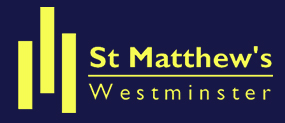School History
For hundreds of years since the 11th century, the area around where St Matthew’s Church and School stands was dominated by Westminster Abbey.
Since its early beginnings, St Matthew's has sought to create a place of Belonging, a place of Believing, and a place of Achieving for all its children. These three core values give the foundation for our community, and are informed by our Christian understanding of koinonia, faith and wisdom. Our school Christian values align closely with our church’s vision – everyone is welcome and an understanding of community in the heart of the city. These shared values have been lived and expressed by our church and school since we were established in the mid nineteenth century.
In 1681, Henry Purcell was living with his family in Great St Anne’s Street, while he was organist at the Abbey.
By 1711, the population of St Margaret’s parish had grown to 20,000 and so the Church Building Commissioners considered that another church should be built in the parish. This church was publicly funded and the land was bought from Henry Smith who was also the Commissioners’ treasurer. At this time, the roads around Smith Square such as North Street and Cowley Street were also developed.
There was a certain amount of industry west of Parliament Square. The gas works dominated the area between Horseferry Road and Great Peter Street. The Broadwood piano factory was situated in Horseferry Road near where the junction with Monck Street is today.
Shortly after St Matthew’s Church had been consecrated, St. Matthew’s School was built immediately adjacent to the church, in St Ann’s Street. There had been a Ragged school in Old Pye Street but this school with a church foundation offered a sound education. A training college for National school teachers was in Victoria Street.
Today, the school building has undergone many transformations since it opened in 1858 and visitors are often surprised to see the amount of space and light behind the big red doors on Old Pye Street.
Our thanks to Jane Kennedy from St Matthew's Church for this research.
